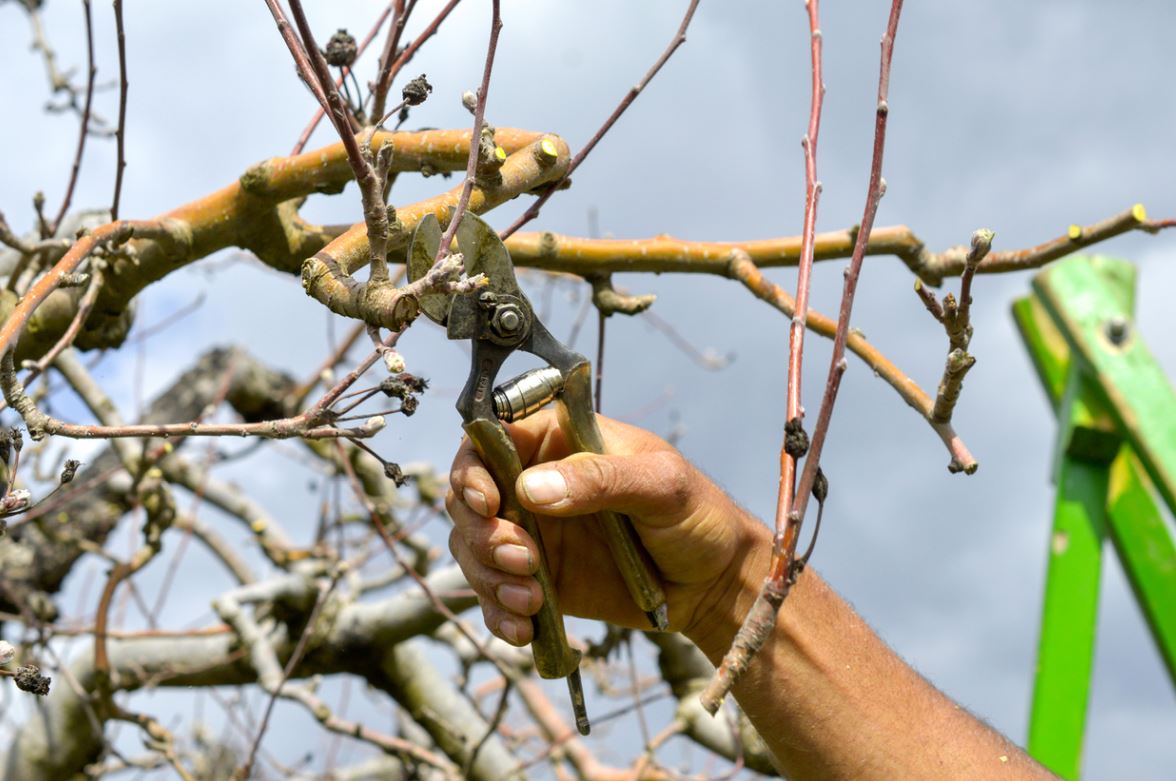Do you love pears and do you think you will harvest them in abundance? So, you have to think about pruning your pear tree. Winter pruning in particular improves the yield of this tree significantly. It is also recommended if you want your tree to keep all its vigor. Follow all of our tips to become a pear pruning champion.
Why carry out a pear tree pruning in winter?
Winter pruning is only for pome fruit trees, such as pear or apple. In contrast, stone trees such as plum, apricot, cherry or peach are pruned in the spring. This choice is made because all branches, even the oldest of the pear tree, bear fruit. Stone trees only bear fruit on the twigs of the previous year.
Plus, pruning this tree in winter simplifies the task. Indeed, the absence of foliage makes it possible to shorten its branches easily. The tree habit and yield will be improved. As the sap flows very little in winter, healing is better, even if it takes longer.
We call winter pruning, trigemma pruning. This name comes from the fact that you only leave three buds on each fruiting branch.
Pear pruning goals
Pruning a pear tree in winter serves different purposes:
- Shorten the branches so that the production is more consistent and of higher quality. The closer the fruit is to a carpenter branch, the more beautiful and tasty it will be.
- Obtain good air circulation by ventilating the heart of the tree. This operation reduces the risk of disease.
- Keep the branches short, but strong, which support large, fleshy fruits. Keep branches facing outward rather than inward, as well as horizontal branches rather than vertical.
- The long, leafy branches often creak under the weight of the fruit. In addition, they take sap that others will not have.
- Forming an aesthetic tree with a balanced habit is also an important objective when pruning.
When to prune your pear trees?
As we have already mentioned, pear tree pruning is done mainly in winter. You do this before the apple trees if you have them, the latter being later. You always start with the trees that are the least vigorous. The period is from December and stretches until the very beginning of spring, in March or April.
You should never prune a pear tree the year it is planted. You will not start until the following year.
Choose a sunny and dry day, it will be more pleasant for you. Avoid all periods of frost, it is indeed very harmful for the healing process which will not be done correctly.
When the buds are formed, you can more easily distinguish the flowering bud from the wood eye. The later you prune in the winter, the more easily they are differentiated.
How to properly prune your pear trees in winter?
The first important thing is to know how to recognize and differentiate wood eyes which will allow the development of a new branch and flower buds that will bear fruit. In winter, they are clearly visible. The wood eye is swollen like the flower bud, which has a more rounded shape. As for the stinger, it is drier and more pointed, it will become wood eye or flower bud.

Shortening size
It is the trigemma size which consists in keeping only three eyes on each side branch starting from its base. Be careful: the third eye is a stinger. The reason is simple, it would become a leafy and barren branch. In this case, cut the branch higher just after a wood eye.
The following winter, you practice pruning in the same way, but in addition, you cut every second branch. The new branches appear after the previous size.
The different steps :
- Remove damaged or dead wood, mummified fruit and crossing branches.
- Aerate the tree by cutting the branches that grow inward.
- Shorten the main branches, the main branches, the larger ones, to about 25 cm. Trim above one eye that points outward. The development of the main branch will be more upright. The side branches benefit better from the sap.
- Prune the side branches above the third eye from the base of it.
- The following winters, you will remove one of the two branches, having developed on the eyes. Preferably choose those that do not bear a flower bud, therefore fruit.
Take advantage of this size for remove lichens and mosses from the bark of the trunk by brushing it. Then brush it with lime, this allows to destroy the wintering pests.
The size of your pear tree cord
As part of the pruning of corded trees, you keep at least two carpenter branches, located on either side of the trunk, horizontally. Thanks to this position of the branches, the circulation of sap is ensured and productivity is optimal.
The different sizes of the pear tree cord:
Maintenance pruning : it consists in cutting the vertical shoots coming from the carpenter branches, with two eyes.
Fruiting size : during this size, shorten the spurts above 2e or 3e bud. Favor flower buds.
How to carry out the summer pruning of your pear trees?
Summer pruning is also called the size in green. This is done in July. You make it with a small secateurs.
You start by removing some pears, after they have naturally fallen in June. With a fine chisel, remove some fruit by not keeping only 10 to 15 fruits per meter of carpenter branches. Keep the larger fruit.
On pear trees in the open air or in a goblet, using a strong pruning shears, remove the suckers that have developed poorly in winter. They often give two shoots, one obliquely and the other vertical. Here’s how to do it:
- Cut the very vertical and vigorous shoots that develop on the carpenters, flush.
- Keep the shoots oblique and prune them above the 8e eye. This avoids giving them too much force.
On trellised pear trees, pinch the branches a few millimeters above a leaf:
- Keep 5-7 leaves starting from the trunk on new shoots without fruit.
- Keep 5 to 7 leaves after the fruit if the branch bears some.
- Remove all twigs, which may shade the fruit and which consume sap for nothing.
Read also :








